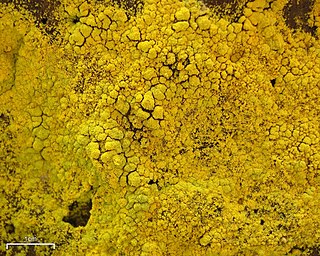
Chrysothrix candelaris, commonly known as the mustard powder lichen or gold dust lichen, is a species of leprose (powdery) lichen in the family Chrysothricaceae. It typically grows on tree bark, although it has also been recorded growing on rock. It does not show ascocarps or other reproductive structures, belonging to the group commonly known as the 'Fungi or lichens imperfecti' in the UK.
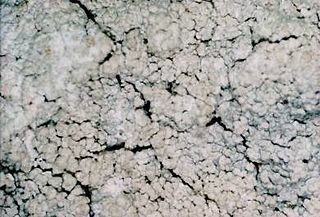
Lepraria is a genus of leprose crustose lichens that grows on its substrate like patches of granular, caked up, mealy dust grains. Members of the genus are commonly called dust lichens. The main vegetative body (thallus) is made of patches of soredia. There are no known mechanisms for sexual reproduction, yet members of the genus continue to speciate. Some species can form marginal lobes and appear squamulose. Because of the morphological simplicity of the thallus and the absence of sexual structures, the composition of lichen products are important characters to distinguish between similar species in Lepraria.

Chrysothrix is a genus of lichen-forming fungi in the family Chrysothricaceae. They are commonly called gold dust lichens or sulfur dust lichens, because they are bright yellow to greenish-yellow, sometimes flecked with orange, and composed entirely of powdery soredia. Apothecia are never present in North American specimens.
Jack Rodney Laundon was a British lichenologist and became President of the British Lichen Society.
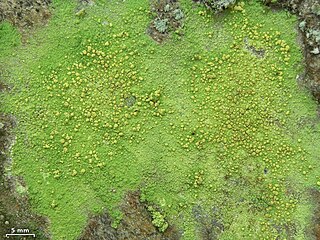
Psilolechia lucida is a species of saxicolous lichen in the family Psilolechiaceae. It is widely distributed through the world, where it grows on natural and artificial rocky substrates in the shade, often in sheltered underhangs. It forms a greenish crust on the surface of its substrate.

Pyxine sorediata, commonly known as mustard lichen, is a widely distributed species of foliose lichen in the family Caliciaceae. It has a subtropical to warm temperate distribution, and grows on bark, rocks, and moss as substrates. Pyxine sorediata has been reported from regions of North America, Europe, Africa, Asia, and Australasia.

Allographa leptospora is a species of script lichen in the family Graphidaceae. The lichen was first formally described in 1921 by Finnish lichenologist Edvard August Vainio as Graphis leptospora. The type specimen was collected in 1904 by German botanist Carl Curt Hosseus on Doi Suthep, where it was found growing on tree bark. Hosseus sent this and other lichens collected from Thailand to Vainio for identification. Robert Lücking and Klaus Kalb transferred it to the genus Allographa in 2018. In 2016, the lichen was reported from the Sintra Mountains, Portugal, which was its first documented occurrence in Europe.

Lepraria incana is a species of dust lichen in the family Stereocaulaceae. First described scientifically by Johann Jacob Dillenius in 1741, and then formally by Carl Linnaeus in 1753, it is the type species of the genus Lepraria. The thallus of this species is green to greyish-green, and powdery – as if made of tiny granules. These granules are soredia, which are asexual reproductive structures. Like most members of genus Lepraria, the lichen has few distinguishing features, lacking both a medulla and sexual reproductive structures (apothecia). Chemically, the lichen is characterised by the presence of the secondary chemicals known as divaricatic acid and zeorin.

Lepraria harrisiana is a species of leprose lichen in the family Stereocaulaceae. It is widespread in the eastern United States where it occurs in humid habitats, such as conifer swamps and riparian forests.
Lepraria salazinica is a species of rock-dwelling, leprose lichen in the family Stereocaulaceae. It is found in the eastern United States.

Chrysothrix flavovirens is a species of crustose and corticolous (bark-dwelling) lichen in the family Chrysotrichaceae. It was formally described as a new species in 1994 by Tor Tønsberg as the sorediate counterpart of the common and widespread Chrysothrix candelaris. The type specimen was collected from Kirkeøy, Norway, where it was found growing on Picea abies. It has a pale greenish-yellow thallus that contains rhizocarpic acid. The lichen is widespread in Europe, and has also been recorded from Japan and North America. In the Atlantic and Mediterranean biogeographic regions of Portugal, it prefers to grow on the acidic bark of coastal conifer trees.
Chrysothrix bergeri is a species of crustose lichen in the family Chrysotrichaceae. It is found in the southeastern United States and the Caribbean, where it grows as a bright yellow, powdery crust on the bark and wood of mostly hardwoods.
Lepraria santosii is a species of crustose lichen in the family Stereocaulaceae. It occurs in Tenerife, in the Canary Islands.
Inoderma sorediatum is a species of crustose lichen in the family Arthoniaceae. It is only known to occur on the bark of trees in Poland's Białowieża National Park. It is differentiated from other species in genus Inoderma by the form of its thallus, which is entirely made of powdery, granular soredia, as well as by the presence of a unique combination of lichen products.

Bacidina pycnidiata is a species of crustose lichen in the family Ramalinaceae. It is widely distributed in Europe and North Asia. It is characterised by its whitish or cream-coloured pycnidia with long and ostiolar necks.
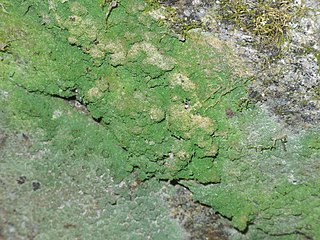
Botryolepraria is a genus of saxicolous (rock-dwelling), byssoid (cottony) lichens of uncertain familial placement in the order Verrucariales. It has two species. Both species grow in damp conditions, such as on cave walls, particularly in areas with minimal light.
Botryolepraria neotropica is a species of saxicolous (rock-dwelling), byssoid (cottony) lichen in the order Verrucariales. It was formally described as a new species in 2010 by Martin Kukwa and Sergio Pérez-Ortega. The type specimen was collected growing with liverworts on shaded vertical walls in El Yunque. It also occurs in Bolivia and Peru, where it grows in shaded and damp locations. The species epithet refers to its Neotropical distribution. It is the second member of Botryolepraria, a genus circumscribed in 1997.

Chrysothrix chamaecyparicola is a species of corticolous (bark-dwelling), crustose lichen in the family Chrysotrichaceae. Found in the eastern United States, it was formally described as a new species in 2010 by lichenologist James Lendemer. Initially thought to be a North American population of the lookalike Chrysothrix flavovirens, it is now recognized as a separate species due to its distinguishing characteristics. It is particularly noted for its strong affinity for the bark of Atlantic white cedar trees and its dominance in conifer swamps across eastern North America.

Chrysothrix insulizans is a species of leprose lichen in the family Chrysotrichaceae. It is a distinctive species of lichen characterized by its bright yellow-green to yellow-orange coloring and unique growth patterns. Most collections have been found growing on rocks, although a few have been recorded growing on bark.
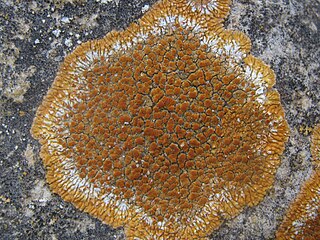
Variospora flavescens is a species of saxicolous (rock-dwelling), crustose lichen in the family Teloschistaceae. It is a common, widely distributed species and has been recorded in Africa, Asia, Europe, and Macaronesia.














